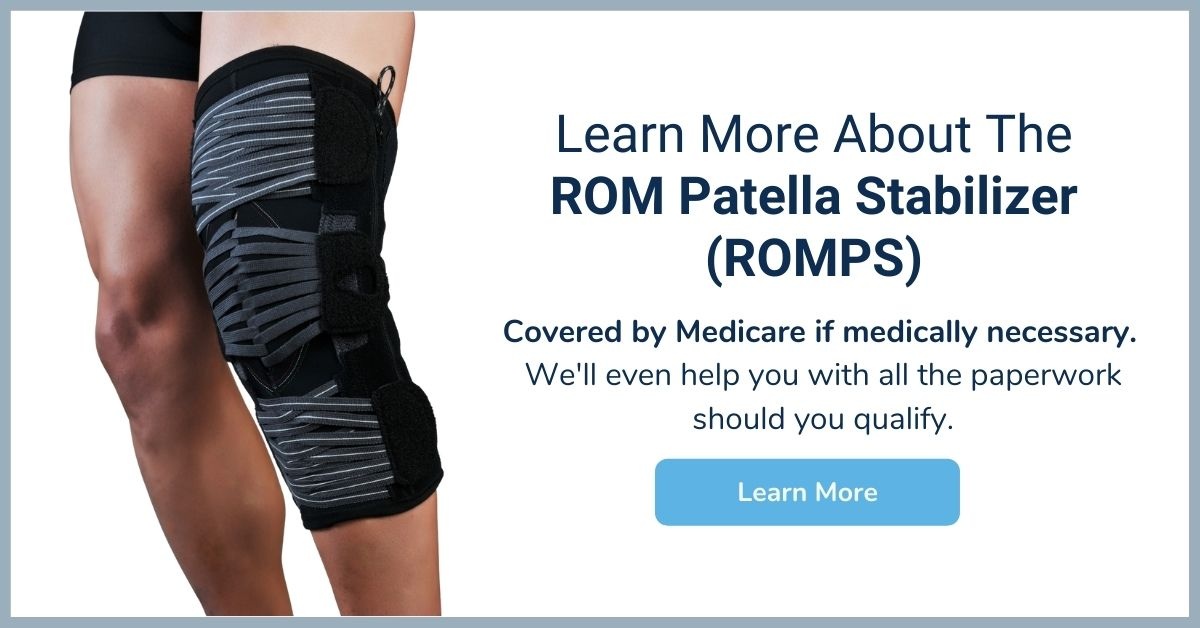How to Manage Patella Instability with a Knee Brace
Patellar instability refers to a range of injuries that occur when the kneecap or patella is displaced from its normal resting place. A common cause of patella instability is a traumatic dislocation during a sporting activity or other daily activities. On average, the condition affects between 7and 49 out of 100,000 people in the United States. People in their teens and twenties, especially adolescent female athletes, are often more susceptible to kneecap instability. To treat patellar instability, doctors commonly recommend a combination of strengthening exercises and knee bracing to reduce pain and improve function.
Causes of Kneecap Instability
Changing direction abruptly while running or something directly hitting your knee can force the kneecap to come out of the groove on the end of the thigh bone (kneecap dislocation). It is more common for lateral subluxation of the patella due to muscular imbalances in the quadriceps muscle. In most cases, the kneecap returns to its original place on its own, but at times, you may need the help of a health professional to return the kneecap to the groove through a procedure known as a reduction. Regardless of the means of restoration, your knee will remain painful for some time, and activity will be limited.
Patellar instability may also happen without a specific injury. For instance, the kneecap may come partially out of the groove (kneecap subluxation). This atraumatic injury occurs most often in females, and the kneecap does not stay or rest appropriately in the groove. Although the kneecap may not come entirely out of the groove, you will still feel pain due to the unstable kneecap. The pain will often worsen when walking on uneven terrains, rolling over in bed, or negotiating stairs.
Patellar instability may also result from a combination of other different variables, either modifiable or non-modifiable, including:
• Bone structure instability
• Muscle weakness or imbalance
• Soft tissue malfunction
• Poor movement patterns
How to Manage Patella Instability
The primary goal of nonsurgical treatment for patellar instability is to reduce symptoms, improve quadriceps strength, and restore normal function. The most common non-operative treatment for patella instability is physical therapy focused on establishing optimum lower extremity strength, balance, and function. Although there are no outcome studies on the effectiveness of physical therapy, some reports have shown that this control can reduce the Q angle and minimize the strain on the MPFL.
There are various exercises for patellar tracking disorder that you can do at home in just 20 minutes each day. Regular stretching and strengthening exercises, bracing or taping the knee, and using ice are a few ways you can minimize pain.
Home exercise and physical therapy should incorporate rehab focused on strengthening and stabilizing hip external rotators and core musculature. The recommended duration of non-operative treatment should be 3 to 6 months, but the exercise program should continue over the long-term for optimal functioning.
Knee Braces for Patella Instability
A suitable knee brace can help manage the symptoms of patella instability and restore function. A knee brace such as the ROM Patella Stabilizer (ROMPS) is designed to offer durable, dependable support for patients of all activity levels. With a wide range of heights and designs available, the ROMPS knee brace brings relief to patients with patella instability and other ligament issues. In addition, it comes with horse-shoe padding to restrain the patella in position.
Talk to the Experts!
Elite Medical Supply is a trusted knee, back, and extremity brace supplier that specializes in braces for Medicare beneficiaries. In addition, our staff will closely work with your healthcare provider to offer you the appropriate pain management solution or knee brace. Contact us today to schedule your consultation!
Written by Elite Medical Supply
Braces and Products Covered by Medicare
Browse ProductsRecent Posts
Topics
- Back Braces (30)
- Knee Braces (30)
- Medicare Beneficiaries (28)
- Pain (23)
- Non-Opioid (20)
- Medical Providers (17)
- Product Highlight (10)
- Sciatica (7)
- Working with your doctor (6)
- Bone Growth Stimulator Therapy (4)
- Bone Growth Stimulators (4)
- Wrist Pain (4)
- Carpal Tunnel Syndrome (3)
- Decompression (3)
- Degenerative disc disease (3)
- Lumbar Spinal Stenosis (3)
- Muscle Spasms (3)
- Neuromuscular Electrical Stimulation (NMES) (3)
- Spinal Stenosis (3)
- Unicompartmental Osteoarthritis (OA) (3)
- Wrist Brace (3)
- wrist tendinitis (3)
- Braces for Golf (2)
- Electrical Stimulation (2)
- Failed Spinal Fusion Syndrome (2)
- Fracture healing (2)
- Kyphosis (2)
- Lower back pain (2)
- Lumbago (2)
- SI Joint (2)
- Total Knee Replacement (2)
- Wrist Braces (2)
- Arthritis (1)
- Braces for skiing (1)
- Bulging or herniated disc (1)
- De Quervain Syndrome (1)
- Digital DME Orders (1)
- Herniated Nucleus Pulposus (1)
- Knee Brace Accessory (1)
- Knee Suspension Wrap (1)
- Knee brace support for skiing (1)
- Muscle Atrophy (1)
- PCL (1)
- SI Joint Dysfunction (1)
- Ulnar Tendinitis (1)
![Elite [spine] Medical Supply logo TRN](https://blog.elitemedicalsupply.com/hubfs/Logo%20Files/Elite%20%5Bspine%5D%20Medical%20Supply%20logo%20TRN.png)
